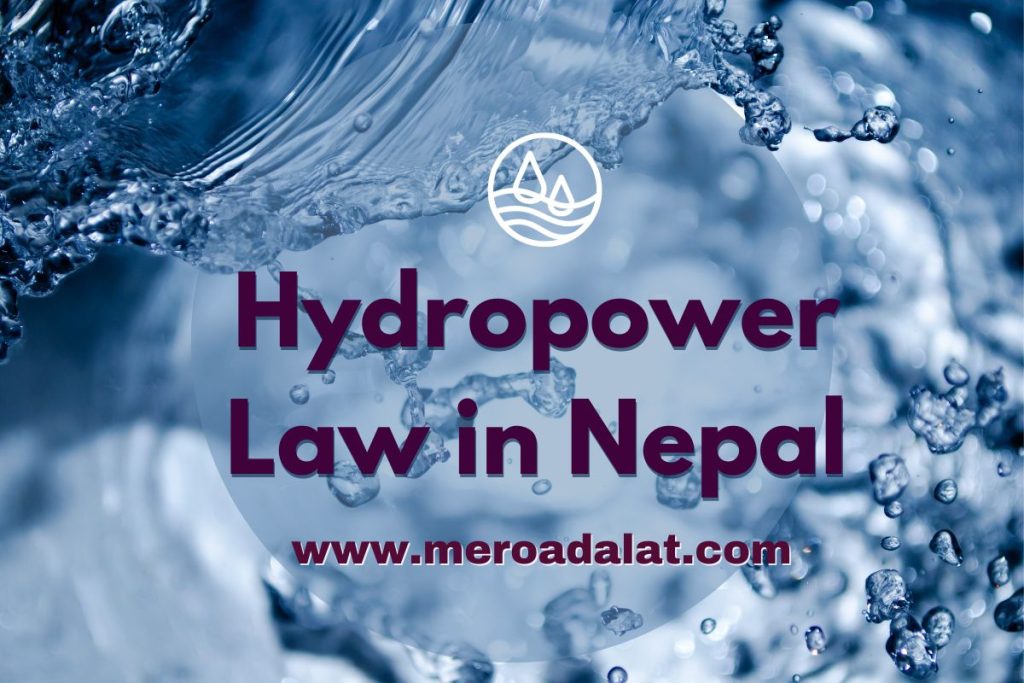This article will guide you through the hydropower law in Nepal and hydropower institutions in Nepal. People around the world and global communities are rapidly moving towards using green, sustainable, and renewable energy. Hydropower in Nepal has a higher potential than other Global Giants because of more than 6,000 Rivers and rivulets and leading water resources globally. It’s essential for citizens and investors alike of both domestic and international sectors to know the legal framework that guides this energy sector, especially while considering that Nepal has a practical Hydropower capacity of 43,000 MW.

Hydropower Law in Nepal – All the Governing Laws
- Electricity Act, 1992 & Electricity Rules, 1993: This legal framework lays the groundwork for licensing electricity projects in the country.
- Electricity Regulatory Commission Act, 2017: This legislation was formed to oversee the production, distribution, and trade of electricity.
- Nepal Electricity Authority Act, 1984: This law governs the Nepal Electricity Authority, which primarily manages the power supply in the nation.
- Public-Private Partnership and Investment Act, 2019: This is pivotal for projects boasting a capacity of over 200 MW or those where the investment exceeds 6 billion.
Hydropower Institutions in Nepal
- Department of Electricity Development: They play the central administrative role. This department has the authority to amend and renew licenses for hydropower projects.
- Investment Board of Nepal: This board becomes involved in projects that exceed a capacity of 200 MW or those with an investment north of 6 billion.
- Electricity Regulatory Commission: This body focuses on the entire lifecycle – production, distribution, and trade of electricity.
Licensing Tenure and Project Ownership
- Survey licenses span 5 years.
- Generation, transmission, and distribution licenses last up to 50 years. Notably, the usual practice is to grant generation licenses for 35 years, with extensions at the discretion of the Department of Electricity Development.
Once a license’s tenure wraps up, project ownership transitions to the Government of Nepal. The initial developer can still operate the project, contingent upon a new agreement.
How is Hydropower Developed in Nepal?
In Nepal, the typical model for hydropower projects is Build Own Operate, and Transfer (BOOT). There are generally three steps to developing such projects:
- Licensing Route (Electricity Act Section 3): This two-phase process involves obtaining a survey license for feasibility, followed by a generation, transmission, or distribution license based on project viability.
- Direct Government Agreement (Section 35 of the Electricity Act): Some entities enter into a direct agreement with the Nepalese government, although the exact scope and rights remain somewhat ambiguous.
- Competitive Bidding: This involves winning projects either initially surveyed by government entities or those whose licenses were previously declared invalid.
Fiscal Incentives to Boost Investment
Corporate Tax: The Corporate Tax for Hydropower in Nepal stands at 20%
Income Tax Perks: Complete exemption for the initial 10 years and a subsequent 50% cut for the next five years.
VAT and Customs Benefits: Importing machinery attracts zero VAT, while a minimal 1% customs duty applies to construction equipment imports.
Financial Cushion: Investors can forward losses for up to 12 years.
Hydropower Project Security in Nepal
Investors can be assured that, during the licensing period, the government will not nationalize any land, buildings, or equipment associated with a developing Hydropower in Nepal.
Power Distribution of Hydropower in Nepal
Electricity generated can be sold domestically or exported. Typically, the Nepal Electricity Authority (NEA) emerges as the chief buyer, although power can also be traded internationally after an export agreement.
Nepal welcomes foreign investment in its hydropower sector, allowing up to 100% foreign investment. Over time, local communities and the public sector have also begun holding shares in hydropower projects.
Conclusion
Hydropower law in Nepal, with its robust legal framework, strategic development models, and attractive fiscal incentives has attracted global investors. As the nation strides forward in harnessing its water resources, it unfurls a canvas of opportunities for those willing to be a part of this transformative journey.
Nepal has empowered Legislation for hydropower development rules, the support of major organizations, and great benefits for those looking to invest. Anyone thinking about getting involved or just wanting to know more can easily see that Nepal is doing exciting things with its rivers to produce energy. Hydropower law in Nepal plays a vital role in enrolling hydropower projects in Nepal.
Also Read: Foreign Direct Investment Law in Nepal
